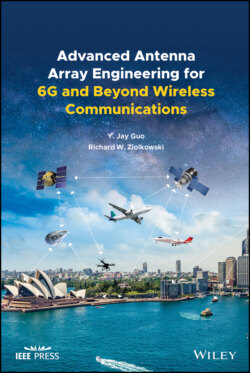Advanced Antenna Array Engineering for 6G and Beyond Wireless Communications

Реклама. ООО «ЛитРес», ИНН: 7719571260.
Оглавление
Richard W. Ziolkowski. Advanced Antenna Array Engineering for 6G and Beyond Wireless Communications
Table of Contents
List of Tables
List of Illustrations
Guide
Pages
Advanced Antenna Array Engineering for 6G and Beyond Wireless Communications
Author Biographies
Acknowledgments
1 A Perspective of Antennas for 5G and 6G
1.1 5G Requirements of Antenna Arrays
1.1.1 Array Characteristics
1.1.2 Frequency Bands
1.1.3 Component Integration and Antennas‐in‐Package (AiP)
1.2 6G and Its Antenna Requirements
1.3 From Digital to Hybrid Multiple Beamforming
1.3.1 Digital Beamforming
1.3.2 Hybrid Beamforming
1.4 Analog Multiple Beamforming
1.4.1 Butler Matrix
1.4.2 Luneburg Lenses
1.5 Millimeter‐Wave Antennas
1.6 THz Antennas
1.7 Lens Antennas
1.8 SIMO and MIMO Multi‐Beam Antennas
1.9 In‐Band Full Duplex Antennas
1.10 Conclusions
References
2 Millimeter‐Wave Beamforming Networks
2.1 Circuit‐Type BFNs: SIW‐Based Butler and Nolen Matrixes
2.1.1 Butler Matrix for One‐Dimensional Multi‐Beam Arrays
2.1.2 Butler Matrix for a 1‐D Multi‐Beam Array with Low Sidelobes
2.1.3 Butler Matrix for 2‐D Multi‐Beam Arrays
2.1.4 Nolen Matrix
2.2 Quasi Optical BFNs: Rotman Lens and Reflectors. 2.2.1 Rotman Lens
2.2.2 Reflectors
2.2.2.1 Single Reflectors
2.2.2.2 Dual Reflectors
2.3 Conclusions
References
3 Decoupling Methods for Antenna Arrays
3.1 Electromagnetic Bandgap Structures
3.2 Defected Ground Structures
3.3 Neutralization Lines
3.4 Array‐Antenna Decoupling Surfaces
3.5 Metamaterial Structures
3.6 Parasitic Resonators
3.7 Polarization Decoupling
3.8 Conclusions
References
4 De‐scattering Methods for Coexistent Antenna Arrays
4.1 De‐scattering vs. Decoupling in Coexistent Antenna Arrays
4.2 Mantle Cloak De‐scattering
4.3 Lumped‐Choke De‐scattering
4.4 Distributed‐Choke De‐scattering
4.5 Mitigating the Effect of HB Antennas on LB Antennas
4.6 Conclusions
References
5 Differential‐Fed Antenna Arrays
5.1 Differential Systems
5.2 Differential‐Fed Antenna Elements
5.2.1 Linearly Polarized Differential Antennas
5.2.2 Circularly Polarized Differential Antennas
5.3 Differential‐Fed Antenna Arrays
5.3.1 Balanced Power Dividers
5.3.2 Differential‐Fed Antenna Arrays Employing Balanced Power Dividers
5.4 Differential‐Fed Multi‐Beam Antennas
5.5 Conclusion
References
6 Conformal Transmitarrays
6.1 Conformal Transmitarray Challenges. 6.1.1 Ultrathin Element with High Transmission Efficiency
6.1.2 Beam Scanning and Multi‐Beam Operation
6.2 Conformal Transmitarrays Employing Triple‐Layer Elements. 6.2.1 Element Designs
6.2.2 Conformal Transmitarray Design
6.3 Beam Scanning Conformal Transmitarrays
6.3.1 Scanning Mechanism
6.3.2 Experimental Results
6.3.3 Limits of the Beam Scanning Range
6.4 Conformal Transmitarray Employing Ultrathin Dual‐Layer Huygens Elements
6.4.1 Huygens Surface Theory
6.4.2 Ultrathin Dual‐Layer Huygens Elements
6.4.3 Conformal Transmitarray Design
6.5 Elliptically Conformal Multi‐Beam Transmitarray with Wide‐Angle Scanning Ability
6.5.1 Multi‐Beam Transmitarray Design
6.5.2 Concept Verification Through Simulation
6.6 Conclusions
References
7 Frequency‐Independent Beam Scanning Leaky‐Wave Antennas
7.1 Reconfigurable Fabry–Pérot (FP) LWA
7.1.1 Analysis of 1‐D Fabry–Pérot LWA
7.1.2 Effect of Cj on the Leaky‐Mode Dispersion Curves
7.1.3 Optimization of the FP Cavity Height
7.1.4 Antenna Prototype and Measured Results
7.2 Period‐Reconfigurable SIW‐Based LWA
7.2.1 Antenna Configuration and Element Design
7.2.2 Suppression of Higher‐Order Harmonics
7.2.3 Element Activation States and Scanning Properties
Example
Example 7.2
7.2.4 Results and Discussion
7.2.4.1 Element Pattern and Antenna Prototype
7.2.4.2 Radiation Patterns and S‐Parameters
7.3 Reconfigurable Composite Right/Left‐Handed LWA
7.3.1 Parametric Analysis
7.3.2 Initial Frequency‐Scanning CRLH LWA
7.3.3 Reconfigurable Fixed-Frequency Scanning CRLH LWA
7.3.3.1 Antenna Configuration
7.3.3.2 DC Biasing Strategy
7.3.3.3 Simulation Results
7.3.3.4 Measured Results
7.3.3.5 Discussions
7.4 Two‐Dimensional Multi‐Beam LWA
7.4.1 Antenna Design
7.4.1.1 Horn BFN
7.4.1.2 Phase‐Compensation Method
7.4.1.3 Phase Shifter Based on Phase Inverter
7.4.1.4 Fixed‐Frequency Beam Scanning Leaky‐Wave Antenna
7.4.2 Performance and Discussion
7.5 Conclusions
References
8 Beam Pattern Synthesis of Analog Arrays
8.1 Thinned Antenna Arrays
8.1.1 Modified Iterative FFT
8.1.2 Examples of Thinned Arrays
8.2 Arrays with Rotated Elements
8.2.1 The Pattern of an Element‐Rotated Array
8.2.2 Vectorial Shaped Pattern Synthesis Using Joint Rotation/Phase Optimization
8.2.3 The Algorithm
8.2.4 Examples of Pattern Synthesis Based on Element Rotation and Phase. 8.2.4.1 Flat‐Top Pattern Synthesis with a Rotated U‐Slot Loaded Microstrip Antenna Array
8.2.4.2 Circular Flat‐Top Pattern Synthesis for a Planar Array with Rotated Cavity‐Backed Patch Antennas
8.3 Arrays with Tracking Abilities Employing Sum and Difference Patterns
8.3.1 Nonuniformly Spaced Dipole‐Rotated Linear Array
8.3.2 PSO‐Based Element Rotation and Position Optimization
8.3.3 Examples. 8.3.3.1 Synthesis of a 56‐Element Sparse Linear Dipole Array
8.3.3.2 Synthesizing Sum and Difference Patterns with Multi‐Region SLL and XPL Constraints
8.4 Synthesis of SIMO Arrays
8.4.1 Analog Dual‐Beam Antenna Arrays with Linear Phase Distribution
8.4.2 Phase‐Only Optimization of Multi‐Beam Arrays
8.4.3 The Algorithm
8.4.4 Simulation Examples
8.5 Conclusions
References
Index
a
b
c
d
e
f
g
h
i
j
l
m
n
o
p
q
r
s
t
u
v
w
WILEY END USER LICENSE AGREEMENT
Отрывок из книги
IEEE Press 445 Hoes Lane Piscataway, NJ 08854
.....
It must be noted that commercial 6‐bit digital phase shifter mm‐wave integrated circuits (MMICs) are available for a range of LO and IF frequencies suitable for mm‐wave arrays. These devices provide 360° of phase change with a least significant bit (LSB) of 5.625°. This resolution allows analog beamforming with a scan angle accuracy to a fraction of a degree. The system configuration in Figure 1.5d is particularly attractive since the devices in the LO path are typically operated in saturation. Consequently, variable losses that usually change with any phase shift are avoided in this scheme.
It is should be pointed out that a more elegant and highly desirable solution to forming multiple beams in a hybrid fashion is to employ analog multi‐beam antennas rather than using subarrays of antenna elements. In principle, the entire antenna aperture can be shared by all the users. However, the generation of multiple individually steerable analog beams is in itself a huge challenge. Unfortunately, there exist only a very limited number of solutions that can be incorporated into the hybrid beamforming configurations discussed above. A number of the remaining chapters in this book will explore various ideas to fill such current technology gaps.
.....